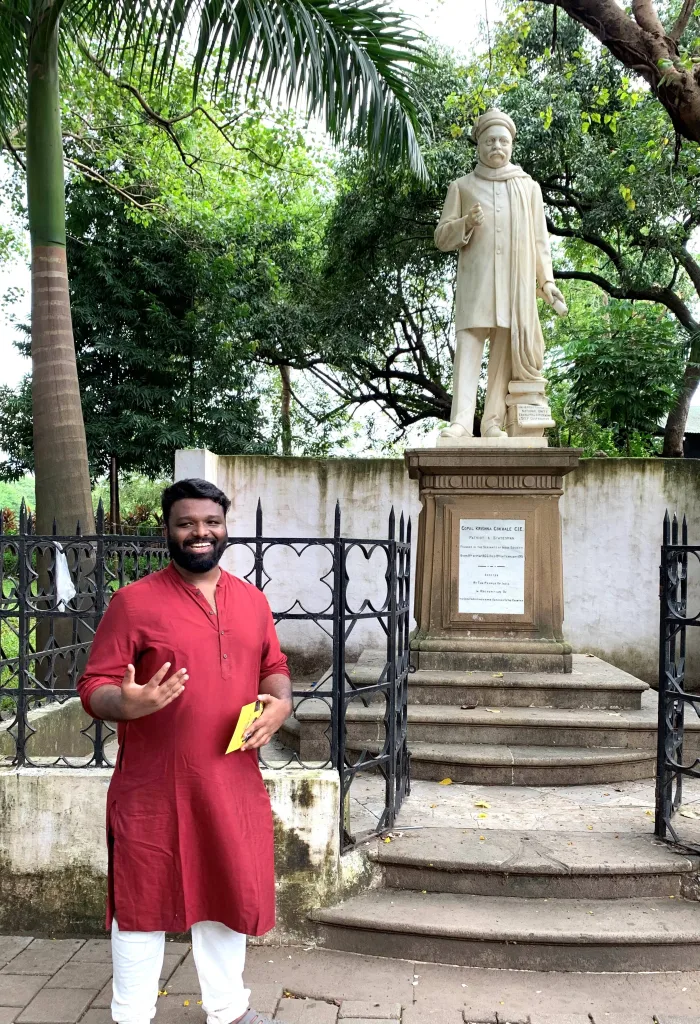Welcome to our exclusive interview series, Young Professionals in Heritage, where we delve into the vibrant world of young heritage professionals. This series shines a spotlight on the dynamic individuals who are shaping the future of the heritage sector.
Each week our guests will share their unique journeys, detailing the roles they play in safeguarding our cultural and historical treasures. They will discuss the challenges they face in this evolving field. Our aim is to highlight the diverse professions within heritage work and to celebrate the fresh, forward-thinking approaches of the next generation.
Today’s guest is Sandesh Awdan. Sandesh is a historian and conducts heritage walls in and around Mumbai. His walks specialise in giving not just a historical perspective of the place but also socio-political insight into the different time periods. He also runs a historical blog called Sthapatya Samvaad.
We haven’t tapped school children yet for heritage walks, heritage walks for children are aligned with India’s New Education Policy 2020 […]

Let’s start with simple questions – Why did you start these heritage walks? And how do you prepare for a Heritage walk? How do you choose a theme and location?
The idea behind starting the heritage walks was to create a kind of space to discuss varied dimensions of heritage, with a purpose to walk towards a comprehensive understanding of heritage. One of the most important aspects of the heritage walk is exchange of information. We are very much interested in people’s reactions, their point of view and their stories associated with particular heritage sites and monuments, it helps us to serve our purpose.
For the walk preparation- I go through lots of primary data and secondary data. I also try to get oral stories associated with heritage sites. Then I go for site seeing, explore possible routes, select spots to halt and try to build a narrative based on the data and route that we select.
How do you choose a theme and location?
Diversity appeals to me, and wherever I notice it, the narrative starts to take shape in my mind. My first heritage walk was just around BMC, CSMT and GPO building at Fort- where one can see a transition from Neo-Gothic architecture to Indo-Saracenic architecture.
Do you get a repeat audience often? Does the audience look at the heritage walk as a hobby – something that they are interested in or do they look at it as a touristic activity?
Yes, we do get a repeat audience, very interestingly the people who attended our Ambarnath Temple Heritage Walk also signed up for the Malabar Hill Heritage Walk, and the people who attended our Art Deco Walk also came for the Ambarnath Temple Heritage Walk. Considering Ambarnath temple is an ancient site and Art Deco and Malabar Hill walk relatively modern, I like that people like this wide range that we are trying to cover.
Heritage walk crowds and tourists are two different audiences I believe. The people who come for heritage walks come with curiosity, to see a site or monument in a slower and better way, as many times audience say they have seen this place several times but we have never seen it the way we see it now (during heritage walk). One of the interesting feedbacks we got was for the CSMT station Walk, an audience said ‘From now onwards I am going to take a pause and take a look at it every time I pass by this place’
But there is one trait in people I noticed akin to touristic activity which is- people do not tend to visit the same site twice. I think they should visit the heritage site whichever they like more than once preferably with different walk leaders because every walk leader has their viewpoint and their own narrative, which will open a new dimension of the same site for them. Heritage sites especially ancient sites like Kanheri, Amabarnath Shiva temple, Mahakali caves, and Elephanta caves are studded with multi-dimensional aspects.
I also think heritage walks are not for tourists especially Indian tourists who want to cover as many spots as possible in the given time, so they prefer a vehicle like the Mumbai Darshana bus.

Heritage walks are one of the popular ways people in big cities are consuming heritage. Ahmedabad is an example wherein heritage walks spread awareness about the city’s history and eventually helped it win a UNESCO tag. Do you think walks like these help spread awareness about Mumbai’s heritage and start a public movement to stop Mumbai’s built heritage from demolition?
Heritage walks can certainly play an important role in building a public movement. Heritage walks help people realise how they are connected to heritage sites/monuments, which I believe is a primary condition for the rise of any such movement.
In a lot of American and European cities, there are scores of museums and monuments that people visit on holidays to consume or experience heritage. Apart from this, there are several trail apps, AR and VR apps, and geotag maps available for people to explore the city’s heritage. Do you think heritage walks are a way in which we are compensating for the lack of heritage infrastructure in India?
Sorry I am not aware of the international scene, so can’t answer this question. But I believe Heritage Walk is a better way to explore heritage sites than any tech gadget since walks encourage a dialogue.
Several heritage walks and tours are operating in Mumbai. What is the future for heritage walks and tours in Mumbai? Do you think the market is saturated or there is still scope for new players?
I think the heritage market will always be open to those coming up with creative ideas and interesting narratives around Heritage. Heritage itself is an ever-evolving phenomenon, its relevance keeps evolving with time, and new players should see it. Apart from that, It is not just the new heritage routes but people are attracted to new activities and new content as well, so as long as new players are coming up with innovative ideas, the heritage market will always welcome them.
Moreover, we haven’t tapped school children yet for heritage walks, heritage walks for children are aligned with India’s New Education Policy 2020, so the market is huge enough for good players.
